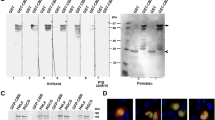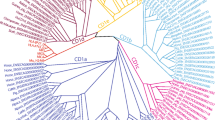Abstract
Murine immune-responsive gene 1 (IRG1) plays significant roles in embryonic implantation and neurodegeneration. The expression pattern of the human IRG1 gene, however, has not yet been established, and the predicted gene sequence has been revised several times according to computed expressed sequence tags (ESTs). To determine the human IRG1 gene expression profile, human fetal tissue samples, peripheral blood mononuclear cells (PBMCs) from normal healthy subjects, and the human leukemia cell lines THP-1 and K-562 challenged with lipopolysaccharide (LPS) were subjected to RT-PCR using degenerate primers. The results indicated that the IRG1 gene is differentially expressed in human fetal PBMCs and LPS-stimulated adult PBMCs. The amplified gene fragment was cloned into the pET32a(+) vector and fusion-expressed with a His-tag in a prokaryotic system. After affinity chromatography, human IRG1h fusion proteins were isolated by SDS-PAGE and identified by mass spectrometric analysis for use as an immunogen to immunize rabbits. The titer and specificity of the purified rabbit antiserum were sufficient to measure human IRG1 gene expression in various tissues and cultures. This purified polyclonal antiserum will allow us to initiate studies to elucidate the biological roles of the human IRG1 gene.






Similar content being viewed by others
References
Nau GJ, Richmond JF, Schlesinger A, Jennings EG, Lander ES, Young RA (2002) Human macrophage activation programs induced by bacterial pathogens. Proc Natl Acad Sci USA 99:1503–1508
Akira S, Takeda K (2004) Toll-like receptor signalling. Nat Rev Immunol 4:499–511
Shimizu T, Kida Y, Kuwano K (2007) Triacylated lipoproteins derived from Mycoplasma pneumoniae activate nuclear factor-kappaB through toll-like receptors 1 and 2. Immunology 121:473–483
Lee CG, Demarquoy J, Jackson MJ, O’Brien WE (1994) Molecular cloning and characterization of a murine LPS-inducible cDNA. J Immunol 152:5758–5767
Basler T, Jeckstadt S, Valentin-Weigand P, Goethe R (2006) Mycobacterium paratuberculosis, Mycobacterium smegmatis, and lipopolysaccharide induce different transcriptional and post-transcriptional regulation of the IRG1 gene in murine macrophages. J Leukoc Biol 79:628–638
Cheon YP, Xu X, Bagchi MK, Bagchi IC (2003) Immune-responsive gene 1 is a novel target of progesterone receptor and plays a critical role during implantation in the mouse. Endocrinology 144:5623–5630
Degrandi D, Hoffmann R, Beuter-Gunia C, Pfeffer K (2009) The proinflammatory cytokine-induced IRG1 protein associates with mitochondria. J Interferon Cytokine Res 29:55–67
Li H, Gang Z, Yuling H, Luokun X, Jie X, Hao L et al (2006) Different neurotropic pathogens elicit neurotoxic CCR9- or neurosupportive CXCR3-expressing microglia. J Immunol 177:3644–3656
Schmidt G, Richter K (2000) Expression pattern of XIRG, a marker for non-neural ectoderm. Dev Genes Evol 210:575–578
Baxevanis AD (2003) Using genomic databases for sequence-based biological discovery. Mol Med 9:185–192
Sen Y, Yongyi B, Yuling H, Luokun X, Li H, Jie X et al (2005) V alpha 24-invariant NKT cells from patients with allergic asthma express CCR9 at high frequency and induce Th2 bias of CD3 + T cells upon CD226 engagement. J Immunol 175:4914–4926
Saracco SA, Hansson M, Scalf M, Walker JM, Smith LM, Vierstra RD (2009) Tandem affinity purification and mass spectrometric analysis of ubiquitylated proteins in Arabidopsis. Plant J 59:344–358
Fu P, Wu J, Guo G (2009) Purification and molecular identification of an antifungal peptide from the hemolymph of Musca domestica (housefly). Cell Mol Immunol 6:245–251
Mayta H, Hancock K, Gilman RH, Zamudio R, Castillo JP, Levine MZ et al (2009) A novel Taenia solium protein that resembles troponin T proteins. J Parasitol 95:591–597
Majoros WH, Korf I, Ohler U (2009) Gene prediction methods. In: Edwards D, Stajich J, Hansen D (eds) Bioinformatics: tools and applications. Springer, New York, pp 99–119
Schmitt AO (2010) Mining expressed sequence tag (EST) libraries for cancer-associated genes. Methods Mol Biol 576:89–98
Suzuki K, Yu X, Chaurand P, Araki Y, Lareyre JJ, Caprioli RM et al (2006) Epididymis-specific promoter-driven gene targeting: a transcription factor which regulates epididymis-specific gene expression. Mol Cell Endocrinol 250:184–189
Rowell E, Merkenschlager M, Wilson CB (2008) Long-range regulation of cytokine gene expression. Curr Opin Immunol 20:272–280
Rodriguez N, Mages J, Dietrich H, Wantia N, Wagner H, Lang R et al (2007) MyD88-dependent changes in the pulmonary transcriptome after infection with Chlamydia pneumoniae. Physiol Genomics 30:134–145
Hoshino K, Kaisho T, Iwabe T, Takeuchi O, Akira S (2002) Differential involvement of IFN-beta in Toll-like receptor-stimulated dendritic cell activation. Int Immunol 14:1225–1231
Tsuchiya S, Yamabe M, Yamaguchi Y, Kobayashi Y, Konno T, Tada K (1980) Establishment and characterization of a human acute monocytic leukemia cell line (THP-1). Int J Cancer 26:171–176
Yuling H, Ruijing X, Li L, Xiang J, Rui Z, Yujuan W et al (2009) EBV-induced human CD8 + NKT cells suppress tumorigenesis by EBV-associated malignancies. Cancer Res 69:7935–7944
Xiao W, Li L, Zhou R, Xiao R, Wang Y, Ji X et al (2009) EBV-induced human CD8(+) NKT cells synergise CD4(+) NKT cells suppressing EBV-associated tumours upon induction of Th1-bias. Cell Mol Immunol 6:367–379
Muench P, Probst S, Schuetz J, Leiprecht N, Busch M, Wesselborg S et al (2010) Cutaneous papillomavirus E6 proteins must interact with p300 and block p53-mediated apoptosis for cellular immortalization and tumorigenesis. Cancer Res 70:6913–6924
Yerly D, Heckerman D, Allen T, Suscovich TJ, Jojic N, Kadie C et al (2008) Design, expression, and processing of epitomized hepatitis C virus-encoded CTL epitopes. J Immunol 181:6361–6370
Frey A, Di Canzio J, Zurakowski D (1998) A statistically defined endpoint titer determination method for immunoassays. J Immunol Methods 221:35–41
Morioka K, Fukai K, Yoshida K, Yamazoe R, Onozato H, Ohashi S et al (2009) Foot-and-mouth disease virus antigen detection enzyme-linked immunosorbent assay using multiserotype-reactive monoclonal antibodies. J Clin Microbiol 47:3663–3668
Reichert JM, Rosensweig CJ, Faden LB, Dewitz MC (2005) Monoclonal antibody successes in the clinic. Nat Biotechnol 23:1073–1078
Pasqualini R, Arap W (2004) Hybridoma-free generation of monoclonal antibodies. Proc Natl Acad Sci USA 101:257–259
Daguindau N, Decot V, Nzietchueng R, Ferrand C, Picard C, Latger-Cannard V et al (2008) Immune constitution monitoring after PBMC transplantation in complete DiGeorge syndrome: an eight-year follow-up. Clin Immunol 128:164–171
Acknowledgments
This study was supported by the grants from the National Natural Science Foundation of China (30730054, 30572119, 30670937, 30971279, 30901363), the Hi-tech Research and Development Program of China from Ministry of Science and Technology (2007AA02Z120), the Ministry of Education (20060486008, 20090141120011), National Innovation Experiment Program for College Students (WU2007061), Provincial Department of Science and Technology of Hubei (2007ABC010), China, and Chang Jiang Scholars Program from Ministry of Education, China and Li Ka Shing Foundation, Hong Kong, China (Chang Jiang Scholar T.J.).
Author information
Authors and Affiliations
Corresponding authors
Additional information
Wei Xiao, Lan Wang, and Ruijing Xiao are contributed equally to this work.
Electronic supplementary material
Below is the link to the electronic supplementary material.
Rights and permissions
About this article
Cite this article
Xiao, W., Wang, L., Xiao, R. et al. Expression profile of human immune-responsive gene 1 and generation and characterization of polyclonal antiserum. Mol Cell Biochem 353, 177–187 (2011). https://doi.org/10.1007/s11010-011-0784-7
Received:
Accepted:
Published:
Issue Date:
DOI: https://doi.org/10.1007/s11010-011-0784-7




